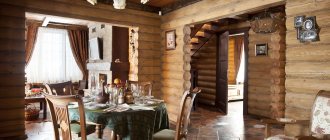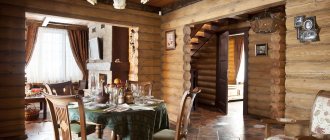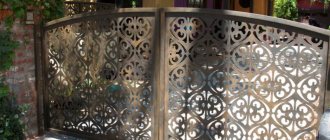The value of the works of ancestors is increasingly significant for contemporaries. And as one of the examples of respect for our great culture, the Russian style in the interior of the apartment began to be revived. The ideal embodiment of this direction would be a room with a stove, which would not be possible in a multi-storey building. However, you can always come up with something. And designers offer to decorate their home in Russian style. Of course, this is not at all an ideal correspondence to the canons, but it will still be beautiful, impressive, and with a Russian spirit, which modern, loft and other popular style solutions lack.
Main features of Russian style in the interior
This direction recreates the conditions in which people lived in Rus' in the 18th and 19th centuries. It clearly distinguishes two varieties.
The first is imitation of a peasant hut, which is characterized by:
- wooden floor, walls and ceiling;
- a large amount of textiles that look as if they were woven right there;
- lack of trinkets, except the simplest and most primitive - clay whistles, for example, or embroidered napkins;
- predominance of bright natural colors.
The living room will look like this: wooden trim, woven rugs on the floor, a heavy, roughly hewn table, benches. Perhaps a chest in the corner or shelves on the walls. No photographs or modern decorations - they stand out.
The second is imitation of the mansion of wealthy townspeople, which is characterized by:
- the same all-wooden finish, but carpets can be hung on the walls and the ceiling can be whitewashed;
- an abundance of textiles, but cleaner, perhaps even factory-made in appearance;
- the presence of trinkets that correspond to the spirit of the time and century;
- the predominance of the same natural bright colors.
The dining room will look different: whitewashed ceiling, carpet on the wall, fluffy carpet on the floor. The table is lighter, more elegant, covered with a tablecloth. Instead of benches there are chairs. There is a samovar on the table as a symbol of hospitality and crowded feasts. Paintings on the walls are allowed, as are framed photographs.
It is easier to implement the second option in an apartment: it does not contrast so much with multi-storey buildings.
Decorating an apartment in Russian style
Decorating a room in the Russian direction is not so easy. Everything should be exclusively environmentally friendly and natural:
- wooden floors. In the "hut" - not varnished, just smooth, without a pattern. In the “mansion” you can put varnished parquet blocks, from which you will then need to form a pattern;
- wooden walls. Since it is impossible to really make them in a multi-story building, all that remains is to sheathe them with panels that will imitate stacked logs. Wallpaper in the Russian folk style is not welcome, although it can be pasted in the “mansion”. The design should be simple - a floral pattern works best;
- wooden ceiling. In the “hut” it is simply made of wood, in the “mansion” it is bleached. No modern materials are used.
Finishing is expensive, since wood is an expensive raw material. The design must be natural, despite the temptation to use plastic panels or linoleum that imitates wood. The fake looks worse and does not give off the specific smell of wood.
Ceiling
Ceilings in village huts in Rus' were traditionally whitewashed.
Interesting fact! The snow-white surface of the ceiling symbolized the cleanliness of the home and indicated that the house was run by a wonderful housewife. But when using open flames for cooking and heating, it is difficult to keep surfaces white.
A great idea is to mount imitation beam ceilings on the ceiling, but whitewashing would also be appropriate. Taking into account the aggressive conditions in a kitchen decorated in the Russian style, you can design suspended ceiling panels and use small patterns to place accents.
Make sure that the ornaments do not attract undue attention.
Styling rooms in Russian style
To successfully decorate a room in the Russian style, it is not necessary to read historical studies and figure out what people in Rus' in the 18th century could use and what they could not. It is enough to be imbued with the spirit of the era, because stylization is not an attempt to turn a house into a reliable museum. Everything needs to be decorated tastefully and beautifully. The general requirements are simple:
- all modern materials should be excluded - wood should predominate, all furniture should be made from it;
- abandon modern decorations - photographs on the walls, factory trinkets, lamps that resemble spotlights should be absent;
- equipment, even in the office, should be hidden in built-in cabinets and cabinets, otherwise it will get knocked out.
If modern gadgets and household appliances are used constantly, it is inconvenient to take them out each time and then put them back, you can cover them with textiles: a napkin, an embroidered piece of fabric. The impression will not be spoiled, and it will be much more convenient to use.
Living room in Russian style
The guest room can be decorated in Russian style. The type of “hut” is:
- a large wooden table in the middle of the room;
- two benches near the table, covered with embroidered pieces of fabric;
- woven rugs on the floor;
- no TV;
- interesting things hung on the walls like bunches of grass, horseshoes, straw dolls and similar little things that are associated with antiquity.
It’s good if there is a samovar - it can be electric, as long as it looks authentic.
In the "mansion" it is better to place chairs instead of benches, cover the table with a white tablecloth with a pattern, and place a gramophone or record player disguised as it in the corner. Hang paintings of classics on the walls.
It is advisable that there be a lamp stylized as a kerosene lamp above the table.
Decoration Materials
In each of the village areas, regardless of ethnicity, only natural materials are used.
Since ancient times, it has been the case that Russian lands were rich in forests, so wood became the main construction and finishing material for furnishing a private home. Wood is still actively used today for finishing modern interiors.
In addition to wood, textiles predominate in the design of Russian cuisine.
The table must be covered with a tablecloth, window openings are decorated with curtains, and rugs are laid on the floor. Furniture is selected with fabric upholstery.
All textile products are certainly decorated with lace and embroidery.
Advice. In a kitchen interior decorated in Russian style, it is recommended to use hand-made embroidery. The same rule applies to lace. Handmade work is easy to distinguish from factory products; Due to this, the atmosphere acquires a unique flavor.
Bedroom in Russian style
There were no bedrooms in the peasant hut; everyone slept on the stove or on benches in a common room. And since it is unusual for a modern person to relax on a hard surface, it is better to stylize the room immediately as a “terem”.
It is necessary to place a bed in the middle of the room (a large one, perhaps with a carved or metal back, always with a lush feather bed, an abundance of pillows and an embroidered bedspread on top, you can use a canopy). You also need to put a table and a chair next to it, a mirror where you can put yourself in order, a large carved cabinet with things, and hang a picture on the wall. You can place a table by the bed, and on it - a candle in a candlestick.
Style characteristics
The key feature of a kitchen interior with a native Russian design is its colorfulness; this design is difficult to confuse with any other.
In Slavic culture at all times, a lot of attention was paid to drawings and symbols. With the help of symbolism, they appeased the spirits that lived in the house and scared away evil spirits.
Drawing is the main distinguishing feature of Russian interiors. In such rooms it is everywhere: on textile elements (embroidery), furniture (intricate carved patterns), surfaces.
Drawing also found its niche in later times, closer to modern times; the ornament was transformed into national painting. We are talking about Khokhloma, haze and Gzhel.
Each of these areas has an individual color scheme and execution technique, which allows you to create a thematic design taking into account shade preferences.
This detail can also be attributed to the peculiarities of Russian design: not all styles are characterized by such diversity.
Features of arranging and decorating a kitchen in the French style: principles of style, choice of finishes, furniture, textiles, lamps, ideas for thematic decor.
A large selection of photos with Greek-style kitchen interiors can be viewed in this article.
Children's room in Russian style
In this style solution, the children's room looks like a bedroom. The only difference is the chest with toys, which needs to be placed somewhere in a visible place.
If the child is still small, then you need to buy not a regular bed, but a cradle. It should be wooden and swing when pushed. Above the bed you can hang a structure made of glass stylized animals - in the 19th century this would have been a real luxury.
The lighting is still the same - with an imitation of antiquity.
Shade range
Russian decor is characterized by a rich palette of shades. It is difficult to say which colors are not used in the design. You only need to avoid eye-catching neon shades. It is recommended to give preference to natural colors.
In such interiors, black is often combined with scarlet and gold, the red-green combination is diluted with blue, blue is used in a duet with snow-white. Another good selection is black with orange and amber.
Each region of our huge country has its own popular color combinations. They are combined into a solid palette, you just have to choose the shades to your liking.
Kitchen in Russian style
It is more difficult to arrange a kitchen in an old Slavic style in an apartment than in a village house. No matter how authentic the design and decoration may be, they will always miss the traditional Russian stove.
This can be solved by decorating the kitchen with a fireplace or stove. This is roughly what people do who want to decorate their apartment or studio in a country style.
Otherwise, the elements are unchanged: simple wooden furniture, old Russian trinkets, not too much light. Be sure to use textiles.
Walls
It is recommended to finish the wall surfaces in a Russian kitchen with wooden paneling. Profiled timber is also a good choice.
But keep in mind that using wood in a kitchen is not very practical: this material gets dirty quickly, and the coating will have to be renewed. In addition, the varnish covering the boards negates the environmental friendliness of the wood.
Experts advise using decorative plaster to cover walls in a kitchen with a Russian design. Another good solution is paintable vinyl wallpaper.
Hallway in Russian style
Historically, in the layout of the hut and tower there was no hallway - only a vestibule, where felt boots, an old snow shovel and similar things usually stood. Therefore, you have to simply decorate the hallway “a la Russe”. Wood trim, wall clock, wooden hanger. Simple design with Old Slavonic chic. You can attach a panel to the wall, cover the window, if there is one, with a patterned curtain or curtains. You also need to come up with other interesting ideas for interior solutions.
Bathroom in Russian style
And even the wealthiest citizens did not have bathrooms in that era. Therefore, all that remains is to furnish a modern bathroom with references to a bathhouse: wooden trim (no wallpaper, tiles), crafts on the shelves, a fluffy broom on the wall, a bath cap on a hook. You can even put a home sauna in the bathroom - this, of course, will require permission to repair and change the layout, but it will fit perfectly into the style and will give you the opportunity to relax and improve your immunity at any time.
Interior of a country house in Russian style
Here you can give free rein to your imagination. Today, designers offer various interiors for a wooden house in the Russian style. It is easier to arrange it than an apartment. If only because you don’t need to decorate the walls with wood, you can just use what you have. There is absolutely no need for a stylized fireplace here. What is important is a real Russian stove, designer painted and decorated. It will look great in photos and can be used for cooking. It sets the tone for the interior and serves as decoration for it. And it is advisable to decorate the rest in the same way as in the apartment: a lot of decor, folk painting, benches instead of chairs, a kind of rural chic.
The main thing is to know when to stop. Do not overdo it with decorative elements and do not turn your country house into a small national museum.
Modern Russian style in the interior personifies long-standing culture and traditions that have survived to this day. When choosing this style solution, it is necessary to properly decorate the room: use natural finishing materials, hide all household appliances, etc. Everything must be done with taste, then the interior will reflect the character of the owners, help them relax and recuperate.
Origin story
Despite numerous disasters, the Russian people managed to preserve their rich cultural code and pass it on to their descendants. The heritage of the Slavs also includes decoration traditions, which were appreciated by representatives of different countries.
Russian style has its roots in ancient Slavic culture, the main feature of which was modesty. There was nothing superfluous in the houses, but only what was necessary for a comfortable life: a stove, a table, benches, sleeping places. Later, images and ornaments began to appear on the walls, and dolls and crafts began to appear in the home itself.
Paganism greatly influenced the interior of the premises. The ancient Slavs believed that objects and nature were of divine origin. This was expressed in the creation of thematic carvings and decor in the form of figurines of idols. The central element of the home of the Russian stove was always kept clean and richly decorated with drawings and paintings: this is how the ancestors pacified the mythical brownie who “lived behind the stove.” Until the mid-15th century, houses were built mainly from logs from the nearby forest.
After Sophia Paleolog, the wife of Tsar Ivan III Vasilyevich, invited an architect from Italy, local craftsmen learned to build houses from stone and brick.











